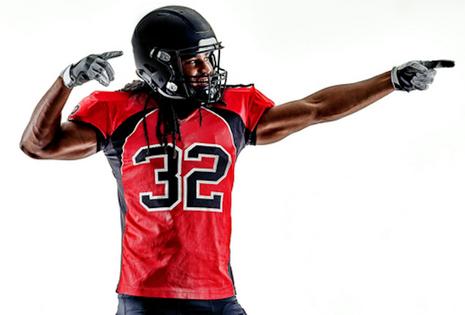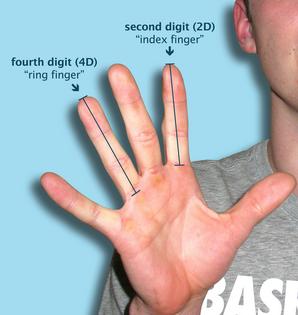Finger size does matter… in sports
Published in Health & Fitness
Examine your fingers. Which is longer? Is it the index finger (the finger you use to point with – technically the second digit, or 2D, counting the thumb), or the ring finger (the fourth digit, or 4D)?
The relative length of the index and ring fingers is known as the digit ratio or the 2D:4D. For example, if your index finger is 2.9 inches (or 7.4 cm) long, and your ring finger is 3.1 inches (or 7.9 cm) long, your digit ratio is 0.935 (i.e., 2.9/3.1 or 7.4/7.9).
Males typically have lower digit ratios (the ring finger in males is typically longer than the index finger) than females (the fingers are about the same length in females). The ratio does not change much with age.
There is some indirect evidence that the digit ratio is determined during early fetal development – as early as the second trimester of pregnancy – by the balance between the steroid hormones testosterone and estrogen. The developing ring finger has a high number of receptors for testosterone: the more testosterone the fetus produces, the longer the ring finger, and so the lower the digit ratio.
Our research team wanted to take this finger research a step further: could the differences predict athletic ability, and, if so, how?
In general, those with lower digit ratios – that is, those whose ring fingers are relatively longer than their pointers – are more likely to perform better across a very wide range of sports and athletic events. This was first illustrated in a detailed study of English professional football (soccer) players.
In 2001, researchers John Manning and Rogan Taylor showed that professional football players had lower digit ratios than nonathletes, first team players had lower ratios than reserve or youth team players, footballers who played for their country had lower ratios than those who hadn’t and those who played for their country more often (more caps) had lower ratios than those who played less often.
Although considerable variability exists across different activities, subsequent research has shown that people with low digit ratios tend to be better at American football (gridiron), basketball, fencing, handball, kabaddi (an Indian contact sport), rowing, rugby, running (both sprinting and cross-country), slalom skiing, sumo wrestling, surfing, swimming, tennis and volleyball.
While the relationship between digit ratio and sports performance is generally stronger in males than in females, important relationships have been seen in females. For example, we published a study in 2015 showing that females with lower ratios rowed substantially faster at the Australian Rowing Championships than females with higher ratios.
The relationships have also generally been stronger for athletes who compete in closed-skill sports (stable, predictable, self-paced environments such as rowing, running, swimming) than athletes who compete in open-skill sports (unstable, unpredictable, externally paced environments such as basketball, football, volleyball). This is probably because single traits, such as the digit ratio, are not usually favorably related to open-skill sports performance because numerous factors determined by the collective actions of all players, not the individual, are involved in sporting success.
...continued













Comments